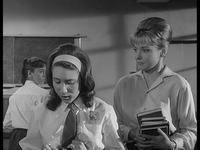 Musician, filmmaker, veteran LA scenemaker and cult film maven Johnny Legend is a jack-of-all-trades who worked in various capacities in the LA pre-hardcore skinflick scene and then in early hardcore adult features, his quick wits and gift of gab serving him well as film scorer, publicity man, maker of trailers, and finally as producer and director of films like the pre-hardcore, hippy/psychedelic/mondo-style Sexual Sensory Perception and this hardcore feature recently rereleased on DVD on his own Raunchy Tonk Video label.
Musician, filmmaker, veteran LA scenemaker and cult film maven Johnny Legend is a jack-of-all-trades who worked in various capacities in the LA pre-hardcore skinflick scene and then in early hardcore adult features, his quick wits and gift of gab serving him well as film scorer, publicity man, maker of trailers, and finally as producer and director of films like the pre-hardcore, hippy/psychedelic/mondo-style Sexual Sensory Perception and this hardcore feature recently rereleased on DVD on his own Raunchy Tonk Video label.The original concept was to do what was then called a "loopfest," in which short soundless 16mm hardcore films or "loops" (then commonly for sale in adult bookstores or through ads in magazines) were compiled with extra footage and/or narration to wrap it all in one cheaply made, feature-length package. But then the concept grew as Legend threw a cruising-Sunset-Boulevard theme and various subplots into the connecting material as well as enlisting friends from another project he was involved in, a band called the Rollin' Rock Rebels, one of the first bands of the rockabilly revival in seventies LA. He also threw in a couple of shorts he had made and the result was billed "the first X-rated rock 'n' roll movie."
Full of lowbrow but genuinely funny humor, the film brings together a vivacious teenager (seventies porn star Serena) eagerly and hornily waiting for her soldier boyfriend (John Galt), a "notorious nuthouse nympho" escaped from the local loony-bin (Christine DeShaffer) who raids a local adult boutique for various, ahem, items, and kidnaps stuffy teacher Dr. Flinch (Bill Margold), and perverted voyeur Willie ("Wild Man" Tony Conn) tries to pick up teenyboppers' lascivious conversations on his tape recorder, and a pair of dim-bulb cruisers (Colin Winski and Jerry Sikorsky) meet with mishaps on the Sunset Strip. Meanwhile KRUZ deejay Mambo Remus (Legend) spins rock'n'roll tracks and everyone meets up at "the end of the line" for a rockabilly rave-up.
Teenage Cruisers was not so popular with the raincoat crowd (not enough porn), but with the couples and porno-chic slummers it was a hit and did what few run-of-the-mill pornos did in the LA theaters it played, which was sell out houses. Part of it might have been the prominent billing of John Holmes and Serena, though Holmes is present only in one of the loops acquired for the film, and Serena, under indictment for obscenity at the time (as well as beginning to be visibly pregnant), decided to only shoot softcore scenes so as not to make her situation worse. Bill Margold, who in George Plimpton fashion was a writer who entered the porn industry in order to write about it, was in similar legal trouble, but decided anyway to perform with then-girlfriend Christine DeSchaffer in the only hardcore sequences actually shot for the film, as "Notorious Nuthouse Nympho Babsy Beaudine" tries to satisfy her insatiable cravings on Dr. Flinch with the aid of a forest of sex toys, a sex-instruction record, a Spanish fly and an endearing gooniness.
There is indeed a lot that is endearing about this film, in part because it is such a low-budget, garage-type project that someone and a bunch of his friends did. Johnny Legend clearly was having fun making the movie, and it shows. Shot MOS (without sound), the audio tracks being dubbed in later by Legend, along with his sister Lynnie (who appears intermittently in the film) and a couple of others, in a dense mix of little gags, throuwaway lines, and bits of incidental music that would appeal very much to today's cult-film audience. And the featured tuneage is good too, with the cream of LA's rockabilly scene contributing: Wild Man Tony Conn, Alvis Wayne, Billy Zoom (best known as guitarist for the LA punk band X), Rollin Colin Winski and Ray Campi.
Keep in mind that the film is sexually explicit and that the humor is fairly raunchy. But the sex scenes do not overpower the rest of the movie, nor is the humor nasty or mean-spirited. Johnny Legend has continued to front bands in the LA area, rerelease cult film titles theatrically and on video, appears on several commentary tracks for Something Weird Video, and making the occasional film, his most recent effort a shot on video feature combining sex and Mexican wrestling called Nympho Libre.
In other news: Thanks to Greg K. in Minneapolis for his efforts in getting me hardware-capable and back on the web and hopefully a more regular posting schedule. While I start gathering my material again after two years of a comatose computer, I will probably be spending a little time straightening the drapes and emptying the ashtrays, but more writing about film is on the stove as we speak.





